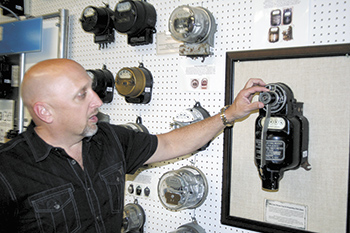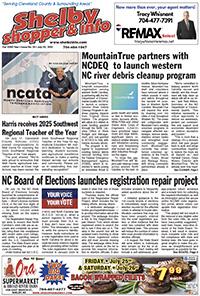| Take a stroll through history at the Lineman's Museum |
|
 Museum founder Andy Price talks about how a pre-paid electricity meter worked from around the turn of the century.
The story of America’s linemen – their sometimes dangerous job and the difficult situations in which they work – is on rich display at one of the area’s least-known museums just a few miles south of downtown Shelby.
Visitors to the well-organized International Lineman’s Museum and Hall of Fame are able to learn not only about the critical industry that nowadays employs more than 200,000 but also take a stroll through the history of transformers, “hot sticks,” glass and ceramic insulators and other tools of the trade. And that’s not to mention a little education about some of the power industry’s early dreamers and innovators, such as Thomas Edison (the father of DC) and Nikola Tesla (the father of AC).
The linemen come to our rescue when the power and phone have been knocked by terrifying storms, wintry weather, fallen trees or other small disasters. They often do their tough jobs out of sight or in the dark of night. We seldom get to meet these unsung heroes.
What is the work like? What kind of training is involved? Just how dangerous is it?
The Lineman’s Museum, located at 529 Caleb Rd., answers many of these questions.
Its exhibits include dazzling photos that show the evolution of the lineman’s job and the power industry through the 20th century. Visitors are able to see in three dimensions just how much the working conditions have changed over the years.
There are photos of men doing their daring jobs high atop power lines. There’s a huge collection of glass and ceramic insulators. Visitors are able to take in a video that documents the story of the Hall of Fame, too.
In one of the museum’s most interesting and eye-catching displays, a mannequin of a lineman of 1960 stands next to a mannequin of a lineman working today. The contrast is stark: the uniforms and tools are worlds apart. There’s also an itemized list of the tools and gear each worker has, then and now. To outfit a line in that bygone era would have cost $104. The cost to outfit a lineman in 2014? More than $1,600.
Along one wall of the second-floor museum are electric meters dating back to the turn of the century. Many will be surprised by one in particular: a coin-operated meter. Yes, that’s right, around the time of the turn of the century, it wasn’t unusual to for power companies to offer a kind of pre-paid electricity at certain establishments such as hotels and boarding houses.
The International Lineman’s Museum and Hall of Fame was started in 1997 as the brainchild of Andy Price, the vice president of American Safety Utility Corporation, a Shelby-based lineman equipment and tools supply company, whose headquarters are located on the campus of the museum.
Price said that his years as a salesman for the company his father founded in 1982 had left with him with a deep curiosity and amazement about the linemen’s legacy. He soon began collecting some of the artifacts and tools of the business.
“I started asking for things,” Price said while giving a recent tour of the museum and talking the plans he has for expansion. “All of a sudden, I had more than I bargained for. Then I started making plans to build it.”
Price said about 95 percent of the items in the museum have been donated, while much of the work has been provided for free by linemen from across the region and the country who have delighted in pitching in to the non-profit museum.
Not long ago, the museum – or a part of it anyway -- went mobile. A truck travels all cross the United States educating the public about the history of the power worker’s job through the years.
Price has ambitious plans for the Lineman’s Museum. With its growing collection, it needs a new home. Plus, he recently acquired a hard-to-find 1945 Studebaker arial ladder truck.
Price said he and the museum’s board of directors haven’t settled on a new location, but they aim to keep it in the Shelby area. Wherever they decide to build it, it will feature a 50-seat theater and a larger space for trucks and other vehicles to be properly displayed. It will also be large enough to house the Hall of Fame, which currently consists of an outdoor monument and terrace.
One of the first things you see upon entering the museum is a map of the United States. Here guests are invited to press a pin into their hometown on the map and sign the guest log, which documents recent guests from as far away as Gallipolis, Ohio, Atlanta, Ga., and Wellesley, Mass.
“We’re not known locally but we get people from all over,” Price said.
For Jenna Rawe, the curator of the museum who divides her time between working for the museum and serving as a graphic designer for American Safety Utility Corporation, it’s been a fascinating sideline.
“The museum is growing,” she said, adding that some of the items are more than 100 years old. “We’re always cataloguing new items and figuring how they fit into the grand scheme of things, historically. It’s interesting because it’s one of the few industries that hasn’t been automated. It’s still very hands-on.”
The International Lineman’s Museum and Hall of Fame is free and open to the public from 8 a.m. to 5 p.m. on Monday through Thursday and 8 a.m. to 4:30 p.m. on Fridays. To learn more about the museum, visit www.linemanmuseum.com or www.mobilelineman.com.
by Dave Blanton
|
|
Printer-friendly format
|
|
|
| Digital Edition |
View This Week's Digital Edition!

|
| Advertisements |
|
|
| |
|




